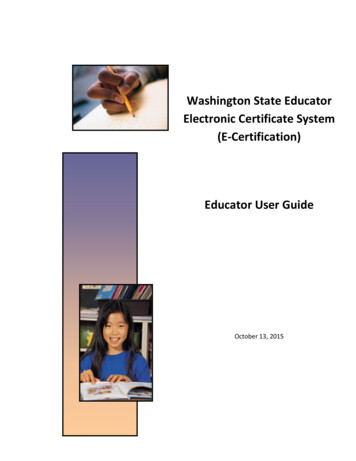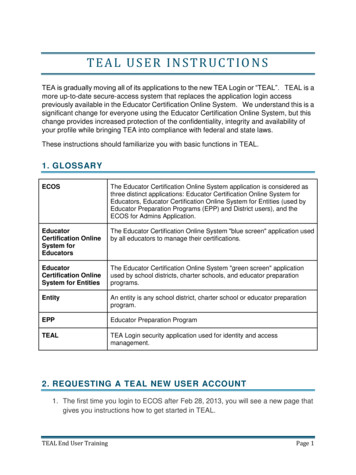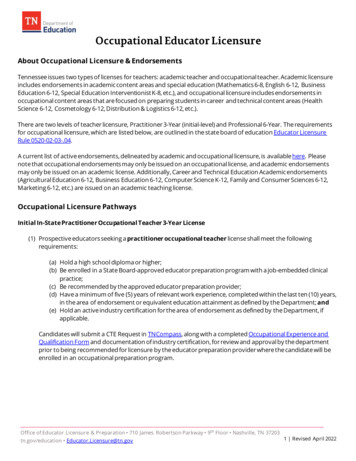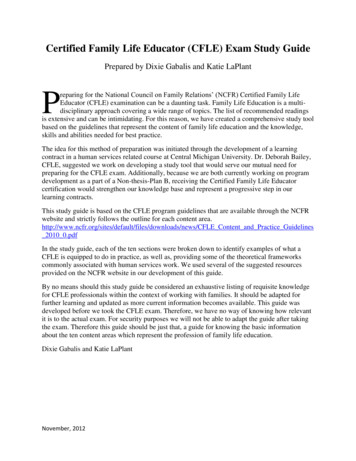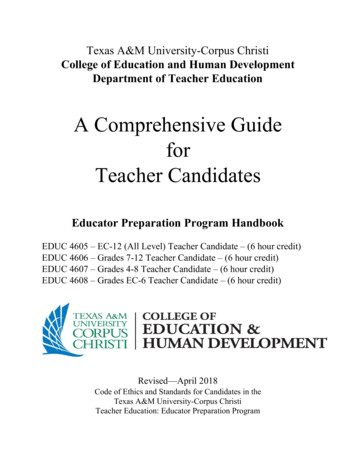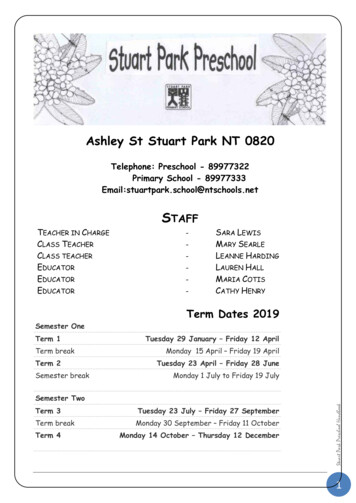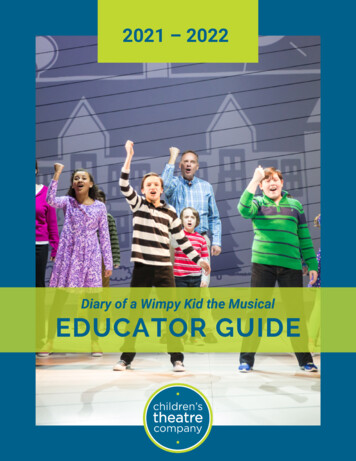
Transcription
2021 – 2022Diary of a Wimpy Kid the MusicalEDUCATOR GUIDE
May 3-June 9, 2022A Children's Theatre Company Original ProductionMiddle school, ugh. It’s the worst. But Greg is determined NOT to be at thebottom of the popularity chart. He’ll leave that to his weird neighbor,Fregley. Or maybe Greg’s best friend, Rowley Jefferson. But it’s not goingto be Greg no way.See Jeff Kinney’s popular character take center stage as Greg’s cartoondiary becomes a hilarious and heartfelt musical. Will Greg’s plans lead himto sacrifice his one true friend? Can anyone avoid the dreaded CheeseTouch? Grab a hall pass and don’t be late for an adventure familiar toanyone who actually survived middle school!music and lyrics by MICHAEL MAHLER and ALAN SCHMUCKLERbook by KEVIN DEL AGUILAdirected by JENN THOMPSONbased on the Diary of a Wimpy Kid book series by JEFF KINNEY and 20th CENTURY STUDIO FILMSproduced by special arrangement with BUENA VISTA THEATRICAL and KEVIN MCCOLLUM 2
TABLE OF CONTENTSSpringboard: Discussion questions & curriculum ideaspage 3Class Act: Classroom activities based in theatrepage 4Team Builder: Classroom activities to build collaborationpage 8Write it Out: Classroom activities based in writingpage 11Worksheet Station: Copyable worksheets & projectspage 12Further Resourcespage 17For virtual activities, videos, andmore, join the creativity on theFlipgrid Discovery Library! 3
SpringboardIdeas of what to talk about, write about, or explore while connectingDiary of a Wimpy Kid to your classroom curriculumWrite a review ofthe performance ora letter to theactors.Define the word"hero." Do you thinkGreg is the hero ofthis story? Why orwhy not?Which characterschange throughoutthe story? How dothey change andwhat lessons dothey learn?How do you definefriendship? Whatmakes someone agood friend?Compare andcontrast yourschool with Greg'sschool.Greg is described as a"wimpy" kid. How doyou define "wimpy?"Find evidence tosupport or contradictthis description.How would youdescribe bullying? Areall kinds of bullying thesame? Why or why not?Who gets bullied in theshow? Who does thebullying?Create an originalstory of how theCheese Touchcame to be.What does it mean to bepopular? Why do you thinkGreg values popularity sohighly? Who are thepopular students at yourschool and why are theypopular?Retell the storyfrom Rowley'spoint of view. Howdoes it change?Why do you thinkGreg keeps ajournal? How does ithelp him? Do youkeep a journal?How do you thinkRowley feels about hisfriendship with Greg? IfRowley kept a journal,how would he describehis interactions withGreg?Ask students to keep ajournal throughout theiryear. What do theynotice? How would theyfeel if their journal waspublished for the worldto see?Design a newcharacter to add tothe series! How dothey intersect withGreg and Rowley?What advicewould you giveGreg on survivingmiddle school?The Wimpy Kid serieshas been translated into45 languages. Why doyou think these storiesare so popular aroundthe world?Which of Greg'sdecisions do youagree with and whichdo you disagree with?What would you dodifferently?What would you doif you got theCheese Touch? 4
Class Act: Actor's ToolsActors use many tools to help them tell a story; three we focus on at CTC are body, voice, andimagination.Explain that projecting means using a loud voice and enunciating means speaking clearly. Havestudents practice projecting and enunciating by saying “Diary of a Wimpy Kid” as a group, and thenindividually.Brainstorm emotions that actors might portray. Try saying “Diary of a Wimpy Kid” using thoseemotions. Students will naturally begin to use their body to portray the emotion as they say the line.Brainstorm how your body looks or feels different when you are feeling these emotions. Allow a fewstudents to showcase their work as a solo.List some of the characters in the play along with characteristics of each. How would each of thosecharacters say the title? Say the line as a group, using different characters as inspiration. Then, askfor volunteers to perform the line individually.Class Act: Character InterviewObjective: In this activity, students will use their imagination to invent backgrounds, justify actions,and answer questions from a character’s perspective. Students will generate questions to betterunderstand a variety of characters and build empathy. Students will offer advice and ideas to helpthe characters.Directions: Place a chair at the front of the room. Ask for a volunteer to come to the front of theclass and pretend to be Greg.The rest of the students will play the role of news reporters who are interviewing Greg for the localnewspaper. The teacher can model by asking Greg a few questions, then invite the class of reportersto ask them questions.Sample questions:“What are you most excited about for middle school?""Why are you concerned with being popular?""What is the hardest thing about being the middle child of the family?""What do you like the most about being friends with Rowley?"After interviewing Greg, do the same activity for other characters in the story such as Rowley, Patty,Manny, Mom, or Dad. 5
Class Act: Narrative PictureObjective: This activity challenges students to compare and contrast characters, infer meaning in apicture, and practice creative problem solving skills. Students will use their imagination to createimagined situations within a sequence of events.Directions: Show the class the illustration by Jeff Kinney below from the novel Diary of a Wimpy Kid.Give each student an opportunity to share with the class what they observe about this picture.Divide students into small groups and have them re-create the picture with their bodies. Once all thestudents are frozen in the scene, allow each to make up a line of dialogue their character/objectwould say. Allow each student in the scene to say what their character/object is thinking in thescene. Reflect on how what we say and what we think are different. How do you decide what to sayout loud and what to keep to yourself?Dismiss students back to their small groups to brainstorm what might have happened right beforethis photo was taken. Create a tableau of this situation.As a large group, analyze the conflict of this scene and brainstorm how this conflict might be solved.Dismiss students back to their small group to crate a tableau of a potential solution to the conflict.Allow each group to showcase all three tableaus (beginning, middle and end) in front of the class.Ask the audience to make observations about the created scenes. How was the conflict solved? 6
Team Builder: Popularity ScoreObjective: This activity makes us challenges students to think about status and helps them noticehow it shows up in the way we move, the way we talk or interact with people, and the way we thinkabout ourselves and others.Directions: Cut out enough slips of paper for each student to get one. Write numbers between 1 and50 on the slips. Make sure you have a wide range of numbers with some low numbers, some middlenumbers, and some high. Mix up these slips and have every student draw a slip WITHOUT looking atthe number. Every student holds their number in front of them/against their forehead/anywhere thatthey can’t see it but everyone else can. This number is their popularity score or status. The highestnumber is the highest status and lowest number is the lowest status.Have students move around the room and interact with other students based on the number eachstudent was assigned. Encourage them to pay attention to body language, both others’ and theirown. Note: no student should be saying anything unkind to each other; focus instead on who you tryand interact with and who you don’t. After students have space to explore this dynamic, challengethem to line up in order of their numbers. Once they are in line, everyone can look at their numbersand see how accurate their line is.Once students have explored the new prompt, have them take a moment to shake off their number(ex. do 10 jumping jacks, have a quick class dance party). If students are ready for the nextchallenge, try this activity again without talking to challenge them to communicate via bodylanguage.Have a conversation about the activity. How did they notice or feel status in themselves and inothers? What did it feel like in your body? How did you interact/not interact with others? Did younotice anything in the activity that you’ve noticed in real life?Team Builder: Mom BucksObjective: In this activity, students will use their imagination to become Greg and Rowley. Thisactivity requires a large open space such as a gym or playground.Directions: Choose one student to play the role of Mom. This student stands at one end of the openspace. Encourage them to use their body to become the character. Sitting next to them is a stool orchair with a stack of "mom bucks” (this can simply be paper).The rest of the students stand at the opposite end of the space. When "mom" turns her back to thegroup, the students can sneak to try to steal the mom bucks. When "mom" turns to face them, theyneed to freeze. If "mom" catches anyone moving, she yells, “to your bedroom,” and the student issent back to the starting line. When a student succeeds in stealing the mom bucks, they become thenew "mom." 7
Team Builder: Bibbity Bibbity BopObjective: This activity gives students a kinesthetic anchor to remember characters. Students willlisten to prompts and respond accordingly.Directions: Everyone stands in a circle with one player in the middle of the circle. That person pointsat someone in the circle and says, as quickly and clearly as possible, “Bibbity, Bibbity, Bop!” In theinterest of clarity, the person who gets pointed at will be called “Z.” Z tries to say “Bop!” before thepointer can finish saying “Bibbity, Bibbity, Bop!”When students are comfortable, add this twist. If the person in the center says only “Bop!” then Zmust remain silent. If Z says “Boo!” then they are out.Keep adding twists as students are comfortable. If the person in the middle gives a prompt to Z, theyrespond with the coordinating frozen image or gesture. Suggestions for prompts are below or havethe classroom develop their own prompts & gestures.PromptGestureMannyThrow your head back and cry like a babyCheese Touch The rest of the class turns their back to Z as Z looks at their hands in horrorLoded DiperZ poses as a rockstar with a microphone and the twostudents on either side become guitar playersTeam Builder: Bully and ProtectorObjective: In this activity, students will build awareness of others and how relationships to peopleimpact how we behave in a group. This activity works best in an open space like a gym orplayground.Directions: Have students start walking around the room or space. As they move, tell them to picktwo people in the group in their head. They should not share the two people they picked or point tomake those people known to their classmates. Challenge them to walk around the space whilekeeping the three people (themselves and the two people they choose) in a triangle with them as thegroup moves. As one person moves, how can you adjust to keep the shape without saying anything?Once students have practiced making a triangle, challenge them to pick two new people in their head(again, not pointing or telling who they chose). One person will be their ‘protector’ and one person willbe their ‘bully'. Students need to move in order to keep their protector in between themselves andtheir bully. Encourage students to do all of this without letting anyone else know who your chosenpeople are.After the activity, discuss what the students' experienced. What was hard about the activity? Howdoes this activity relate to situations students might encounter in real life? 8
Team Builder: Stand Up If.Objective: This exercise activates prior knowledge around concepts or topics in life, reading, andwriting. The exercise also builds community as participants share and observe commonexperiences and celebrate differences.Directions: Ask students to stay seated at their desks. Tell students they will hear a series ofprompts starting with “Stand up if ” If the statement applies to them, they should stand. Choose acouple of students to ask follow-up questions related to the statement. All students sit again beforebeing prompted with another “stand up if” statement.Begin with non-content related prompts to establish the pattern and get everyone moving andlistening. Then move to content related statements that will gradually get more sensitive and/ordetailed as the exercise progresses.Sample Dialogue:“Stand up if ”:General Statements:You like pizzaYou like to readYou play an instrumentYou have seen a play beforeYou have been in a play beforeStatements related to Diary of a Wimpy Kid:You like to write in a journal or diaryYou have met a new friendYou have started a new schoolYou have played a prank on someoneYou have witnessed bullying 9
Team Builder: Late for ClassObjective: This activity challenges students to create a story that justifies why Greg is late for classincluding a beginning, middle, and end. Students will use their bodies to physically communicate thestory.Directions: Choose one student to play Greg. This student will leave the classroom for a moment.Once Greg is out of the room, work as a class to decide the story of why Greg is late for class.Include a beginning, middle, and end (example: First, Greg’s alarm clock didn’t go off, then his busgot a flat tire, finally he got to school on a pogo stick). NOTE: first time around, choose a simple storythat is easily acted out. Give students an opportunity to think about how they will act each part of thestory out.Bring Greg back into the classroom and let him know he is late! He must come to the front of theclass and tell you (the teacher) exactly why he is late. You (the teacher) will stand with your back tothe rest of the students. Students can physically communicate to Greg the reasons he was late.However, if you turn around and look at the class, they must appear as though they were sitting still,not telling him anything. If you hear them, you can eliminate certain players as speaking is not part ofthe game. Once Greg has listed the beginning, middle, and end of his story correctly, he (and theclass) have won! If he cannot correctly tell his story, the teacher wins!You can coach your students along by reminding them to slow down, repeat information, clarify themovement, etc. Once class has the hang of it, you can challenge them with more specificity or morerelation to the book (Greg was late because Roderick’s band played all night and he couldn’t sleep,then Manny ate his alarm clock, and finally Rowley picked him up on his pogo stick and took him toschool).Write It Out: Role on the WallObjective: This activity allows students to brainstorm external and internal factors for characters andcreate deeper, more empathetic understanding of character motivations.Directions: Draw an outline of a person on the board. Choose a character from the play such as Greg,Patty, or Rowley for your shape to represent. Brainstorm all the external things that impact thecharacter (other characters, incidents we see and those we hear about, societal pressures, etc.) andwrite those around the outside of the figure. Next, fill the inside of the character with ideas of howthe character feels about all the things on the outside.Dismiss students to work individually on the activity focusing on a different character. Retell orrewrite the story of Diary of a Wimpy Kid from the perspective of that character. How does thatchange the story? Did this activity change your opinion of that character? Have you ever experiencedsimilar feelings or events? 10
Write it Out: Classroom ComicsObjective: This activity challenges students to create an original comic book with unconventionalcharacters. This activity also encourages students to challenge perspective. This activity works wellwhen paired with the comic book template on page 15.Directions: Select a few existing comic strips such as Calvin & Hobbs, or Garfield and show them tothe class. Brainstorm as a group the similarities and differences between each. What are thecommon characteristics of comic stories?Collect two paper bags and assign a prompt from the table below for each bag. For example, youmight choose to have a “common objects” bag and a “settings” bag. Write examples of these thingson slips of paper and place them in the matching bag. Write enough slips to have one for eachstudent in each bag.Paper Bag PromptsCommon ObjectsEmotionsAnimalsPhysical ActionsCharactersSettingsAllow each student to choose one prompt from each bag and challenge them to write an originalcomic story about those things using the template on page 15.Write it Out: Presidential CampaignObjective: This activity challenges students to write and perform persuasive speeches and thinkabout ways to improve your school community.Directions: Start by talking about the duties of a class president then discuss what qualities in aperson makes a good class president. Brainstorm things that can be improved about your schooland community. What are things you would want to change? What school activities do you wantmore or less of? What things are important to you when it comes to making your school a betterplace?Then, ask each student to write a speech about why they would be a good class president for yourschool: why would YOU be a great representative as Class President? If needed, give students a timelimit or minimum number of sentences based on how much time you have to present speeches.Give each student the opportunity to perform their speech in front of the class. After everyone haspresented, talk about similarities or differences students noticed or hold a class vote for president! 11
Wimpy Kid Venn DiagramUse the Venn Diagram below to compare the original book, a movie adaptation, and themusical of Diary of a Wimpy Kid at Children's Theatre Company.Original Book Seriesby Jeff KinneyMusicalA Moda p v ieiontatatCTC
Finish the ComicWhat do you think is happening in the comic below? Who are the characters? Fill in thespeech bubbles with lines for each character to say.
Create Your Own ComicTry your hand at cartooning, just like Greg! Experiment with communicating a story oridea through pictures and words at the same time, while working within the frames of acomic strip.
School Survival KitBrainstorm your own school survival kit! What makes you feel confident, organized, andprepared for school? Write your answers in the sections of the backpack below. Thesecan be physical things, actions from others, or routines you have put in place to help yousucceed. When you are finished, share your ideas with the rest of the class!Thingsthat help mefeel confident:ThingsThings that help me feel prepared:that help mfeel oerganized:
Corkboard ConversationsUse the sticky notes below to thinkcritically about Diary of a Wimpy Kid.T h isplayibeescrm a dedth a tseiv.je c t a y a r e .dalpeeThrth i sm e fee l .123T h isplaym a deth i n kmea bout .AqI s ti lu e s ti o nl h avels oc iayms t o n o w i s .d polshuoth i sIwgsnuiteaseA sta f te raidmeis.This play taught me .My Rating of Diary of a Wimpy Kidat Children’s Theatre Company 16
FURTHER RESOURCESMore About Diary of a Wimpy Kid"Diary of a Wimpy Kid:DownloadablesReading isFundamentalLiteracy CenterResourcesResourcesAbrams Books Activities& DownloadsPuffin SchoolResource PackActivitiesResourcesTeaching BooksResourcesTeacher VisionResourcesResourcesResourcesBehind the Sceneswith Jeff KinneyAll AboutJeff KinneyWatchLearn MoreMail Letters to:Children’s Theatre Company2400 Third Avenue SouthMinneapolis, MN 55404Submit Student Questions at:www.childrenstheatre.org/offbookquestionsCheck out more activities on:Questions? Email:schools@childrenstheatre.orgMore Fun!Poptropica games createdby Jeff KinneyDrawing Tips fromJeff KinneyPlayLearn MoreWimpy KidYouTube ChannelSneak Peek at aNew Song!WatchWatchPhoto credits by Dan Norman Diary of a Wimpy Kid the Musical, 2016 17
Diary of a Wimpy Kid. book series by JEFF KINNEY and 20th CENTURY STUDIO FILMS produced by special arrangement with BUENA VISTA THEATRICAL. and . KEVIN MCCOLLUM 2. T A B L E O F C O N T E N T S. For virtual activities, videos, and. more, join the creativity on the.


